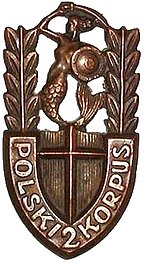2 Polski corpus
|
2 Polski corpus |
|
|---|---|
 Badge of the 2nd Polish Corps |
|
| active | 1943 to 1947 |
| Country |
|
| Armed forces | Polish armed forces in the west |
| Armed forces | Polish Land Forces |
| Type | corps |
| Installation site | Iraq |
| Second World War | Italian campaign |
| Commanders | |
| Lieutenant General | Wladyslaw Anders |
| Divisional officer | Zygmunt Bohusz-Szyszko |
The 2 Korpus Polski ( German 2nd Polish Corps ) was a large military formation of the Polish Army in World War II . After the defeat of Poland , it was set up in Iraq and in 1945 comprised more than 75,000 soldiers. It was under the Polish government in exile and was part of the Polish Armed Forces in the West . The unit was commanded by Lieutenant General Władysław Anders until the end of February 1945 and then by Major Zygmunt Bohusz-Szyszko . After the Yalta Conference , the decisions of which Anders sharply criticized, he demanded the withdrawal of his soldiers from the combat area, which the British rejected.
history
The 2nd Polish Corps was formed in 1943 from the 3rd Carpathian Rifle Division , which was set up in the Middle East in 1942, and the so-called " Anders Army ", which was evacuated to the west via Persia after the German attack on the Soviet Union in 1941 . In 1942 the latter took in the bear Wojtek , who comes from Iran , into their ranks, who not only ensured good morale within the Polish troops, but was also officially accepted into the Polish army in 1944 so that he could cross to Naples , where he was finally in the same year supported the troops in the Battle of Monte Cassino by carrying boxes of mortar projectiles across the battlefield on rough terrain.
In 1944 the corps was moved from Egypt to Italy , where it was subordinated as an independent part of the British 8th Army under General Oliver Leese . The Polish corps fought on the Italian front and took part in the Battle of Monte Cassino , the Battle of Ancona and the Battle of Bologna , among others . The Polish troops made an important contribution in breaking through the main German defense lines, the Gustav Line and the Goths .
At the beginning of 1944 the unit had around 50,000 men. But it suffered heavy losses in the fighting. During the final battle for Monte Cassino, even non-combat units were sent into battle. In the fighting in Italy, 2,301 Corps soldiers were killed, more than 8,000 were wounded and 535 were missing. Since the Soviet Union had in the meantime severed all relations with the Polish government in exile and refused to leave all remaining Poles, the only way to refresh the unity lay in the liberation of prisoner-of-war and concentration camps of the Axis powers . This also happened, so that the unit numbered around 75,000 soldiers by 1945. Parts of the formation, around 20,000, were then sent to the Western Front and thus released from the unit. After the end of the war, parts of the corps remained in Italy. There they were demobilized between 1946 and 1947. The majority of soldiers preferred exile to return to a communist Poland .
composition
|
Origin of the volunteers of the Polish Armed Forces in the West |
||
| Deserters from the Wehrmacht | 89,300 | (35.8%) |
| Evacuated from the USSR in 1941 | 83,000 | (33.7%) |
| Evacuated from France in 1940 | 35,000 | (14.0%) |
| Liberated prisoners of war | 21,750 | (8.7%) |
| Refugees from occupied countries | 14.210 | (5.7%) |
| Recruited in France | 7,000 | (2.8%) |
| Polonia from Argentina , Brazil and Canada | 2,290 | (0.9%) |
| Polonia from England | 1,780 | (0.7%) |
| total | 249,000 | |
In May 1945 the corps comprised 55,780 men and around 1,500 women in the auxiliary units. The majority of the troops consisted of Polish nationals who were deported by the NKVD to the Soviet Union during the Soviet occupation of eastern Poland as a result of the Hitler-Stalin Pact . The 1941 Sikorski-Maiski Agreement released many of these people and allowed them to join the government-in-exile army. These armed forces were set up in southern Russia and Kazakhstan. For political reasons, however, the Soviet leadership withdrew its support for an army loyal to the government in exile. Then Anders transferred his soldiers via Persia and Iraq to British-controlled territory. In Palestine , soldiers were added to them who were able to flee via Romania and Hungary to the then French-ruled Lebanon .
The majority of the soldiers came from the eastern areas of pre-war Poland. Although the majority of them were Poles, Belarusians , Ukrainians and especially Polish Jews also joined the corps. During their stay in what was then the British Mandate of Palestine, many Jewish soldiers deserted to the Haganah . Among them was the future Prime Minister of Israel Menachem Begin . General Anders decided not to pursue the deserters under martial law .
Equipment data
- 248 artillery pieces
- 288 anti-tank guns
- 234 anti-aircraft guns
- 264 tanks
- 1241 armed personnel carriers
- 440 light armored vehicles
- 12,064 cars and trucks
literature
- Władysław Anders: An Army in Exile: The Story of the Second Polish Corps. Macmillan, London 1949.
- Marek Swiecicki: Seven Rivers To Bologna. J. Rolls, London 1946.
- Piotr Żaroń: Armia Polska w ZSRR, na Bliskim i Środkowym Wschodzie. Krajowa Agencja Wydawn, Warszawa 1981.
Web links
Individual evidence
- ↑ CHAPTER ONE: "Our March is towards Poland, Whole, Free and Independent" - The Origins of the Polish Armed Forces Question. . Angelfire.com. Retrieved June 21, 2010.
